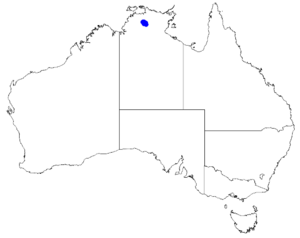Boronia verecunda facts for kids
Quick facts for kids Boronia verecunda |
|
|---|---|
| Scientific classification | |
 |
|
| Occurrence data from Australasian Virtual Herbarium |
Boronia verecunda is a type of small, upright bush. It is found only in a small area of the Northern Territory in Australia. Its flowers are white or pink, but they turn green as the plant's fruit grows. This plant looks quite similar to another plant called B. xanthastrum.
About This Plant
Boronia verecunda is an upright, bushy plant that usually grows to about 40 centimeters (about 16 inches) tall. Its young branches have soft, light pink or white hairs. As the plant gets older, these hairs disappear.
Its leaves are narrow and oval-shaped. They are about 13 to 27 millimeters (about 0.5 to 1 inch) long and 2 to 4 millimeters (about 0.1 to 0.2 inches) wide. They also have tiny white hairs and a very short stalk, usually less than 1 millimeter long.
The flowers grow one by one where the leaves meet the stem. Each flower has a tiny, hairy stalk, about 0.5 to 1 millimeter long. The sepals, which are like small leaves protecting the flower bud, are egg-shaped or triangular. They are about 6 to 7 millimeters long and 1.5 to 3 millimeters wide. These sepals turn green as they get older.
The petals of the flower are white or pink. They are about 3 millimeters long and 2 millimeters wide. Like the sepals, the petals also turn green as they age. The sepals and petals do not get much bigger as the fruit develops.
This plant blooms from January to April. Its fruit is a bumpy, capsule-shaped pod, about 5 millimeters long and 4 millimeters wide.
How It Got Its Name
Boronia verecunda was first officially described in 1997 by a scientist named Marco F. Duretto. He wrote about it in a science journal called Australian Systematic Botany.
The second part of its scientific name, verecunda, comes from a Latin word. This word means "modest" or "blushing." This name was chosen because the plant is small, and its new growth and petals have a soft, blushing color.
Where It Lives
You can find this boronia growing among sandstone rocks and on rocky slopes. It lives near the South Alligator River, inside the famous Kakadu National Park.
Conservation Status
This plant is considered "near threatened." This means it is not yet in immediate danger of disappearing, but it could become threatened in the future. Its status is protected under the Territory Parks and Wildlife Conservation Act 2000.
Images for kids


